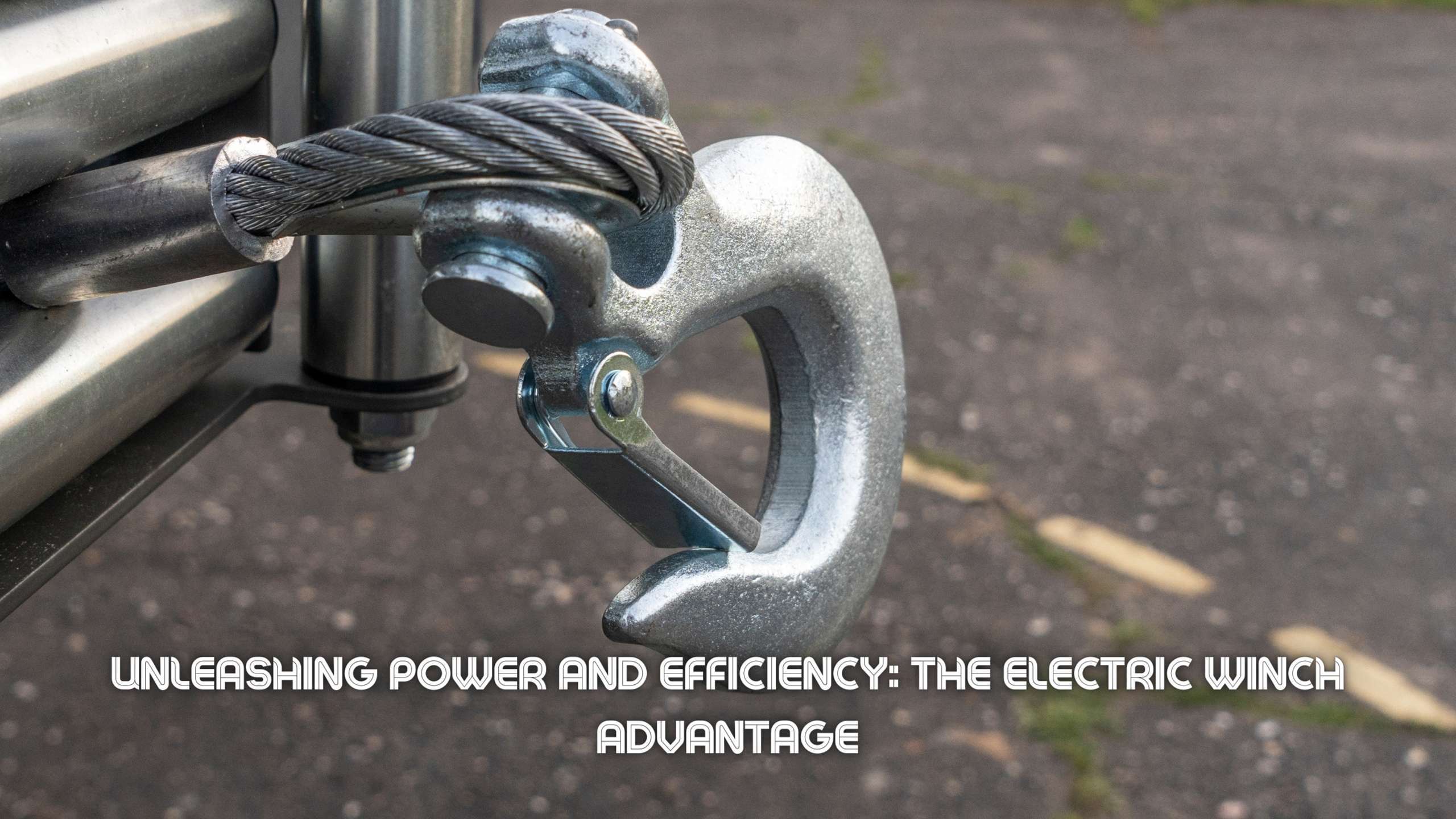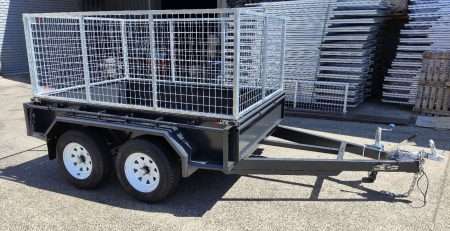
Unleashing Power and Efficiency: The Electric Winch Advantage
Understanding electric winches
When it comes to lifting or pulling heavy loads, a winch can be indispensable. Among the various types of winches available, electric winches are gaining popularity due to their high power, efficiency, and convenience. Let’s delve into the basics of electric winches and explore their common uses.
The Basics of Electric Winches
An electric motor powers a mechanical device called an electric winch. It stands out from manual winches in terms of power and efficiency, making it suitable for handling heavier loads with less effort and time. While manual winches require significant physical strength and effort from the operator, electric winches offer the convenience of remote operation, enhancing safety and ease of use (MTN Shop).
Electric winches are also deemed more environmentally friendly than their hydraulic counterparts, as they do not require hydraulic fluid and have lower emissions. Moreover, they are quieter during operation, making them beneficial in noise-sensitive environments (Thern).
In terms of cost-effectiveness, electric winches have a lower initial cost compared to hydraulic winches, making them an affordable choice for many applications (Thern). They are also compact and lightweight, which simplifies installation and transport and requires less space for operation (Thern).
Common Uses of Electric Winches
Electric winches find a wide range of applications in various industries where heavy lifting or pulling is required. They are commonly used in the construction, marine, and automotive industries.
In the automotive industry, electric winches can be found on off-road vehicles and trailers, where they assist in recovery operations or loading heavy cargo. For those interested in learning more about automotive accessories, check out our articles on the trailer brake controller, trailer hitch lock, hitch receiver, trailer wiring harness, and trailer light kit.
In the marine environment, electric winches, such as the boat trailer winch, are used to pull boats onto trailers or to hoist heavy sails.
For recreational applications, electric winches, like the ATV winch, are used for off-road recovery operations and are typically mounted on all-terrain vehicles.
Whether it’s for industry or adventure, an electric winch can be a powerful and efficient tool. Understanding its operation and common uses can help you harness its full potential.
Benefits of Electric Winches
An electric winch is a powerful tool that offers a multitude of benefits in a variety of applications. Whether it’s for construction, marine, or automotive use, an electric winch provides efficiency, convenience, and environmental advantages over other types of winches.
Efficiency and power
One of the primary benefits of an electric winch is its power and efficiency. According to MTN Shop, electric winches provide more power and efficiency compared to manual winches, making them suitable for heavier loads requiring less effort and time to lift or pull. These winches are highly efficient and require less maintenance compared to hydraulic winches. They also have faster response times and greater control precision, according to Thern.
Convenience and safety
Electric winches offer significant convenience and safety advantages. They are operated using a motor and can be controlled remotely, providing convenience and safety to the operator. Electric winches are also compact and lightweight, making them easier to install and transport. They also require less space for operation. Additionally, electric winches provide more control and precision in winching operations due to their ability to control pulling speed electronically (4 wheel parts).
Environmental Considerations
When it comes to environmental considerations, electric winches outperform their hydraulic counterparts. As per Thern, electric winches are more environmentally friendly than hydraulic winches as they do not require hydraulic fluid and have lower emissions. Additionally, electric winches are quieter and produce less noise during operation, which can be beneficial in noise-sensitive environments.
In conclusion, an electric winch is a powerful, efficient, and environmentally friendly tool that offers numerous benefits over other types of winches. Its ease of use, affordability, and convenience make it a popular choice for a wide range of applications. Whether you need a trailer winch, a boat trailer winch, or an ATV winch, an electric winch is a solid choice.
Electric Winch Components
Understanding the components of an electric winch is key to maximising its power, efficiency, and convenience. These components include the motor, the rope, and the controls used for operation and installation.
Motor Types
The motor forms the heart of the electric winch. The two main types of motors used in electric winches are permanent magnet (PM) motors and series wound (SW) motors. PM motors are considered suitable for occasional use due to their efficient yet moderate power output. On the other hand, SW motors are designed for heavy-duty or cold-weather use, boasting robust performance even in demanding conditions (Driving Fast).
| Motor Type | Suitable For |
|---|---|
| PM (permanent magnet) | Occasional use |
| SW (Series Wound) | Heavy-duty or cold-weather use |
Rope Options
The rope is another critical component of an electric winch. The two primary options available are steel cable and synthetic rope. Steel cable is highly durable and easy to maintain, making it suitable for abrasive terrain. However, it can be heavy and potentially hazardous if broken under tension.
On the other hand, synthetic rope is lighter and safer to use, reducing the risk of injury in the event of a snap. However, it is susceptible to UV exposure, heat, chemicals, and abrasion and therefore requires proper care and handling (driving fast).
| Rope Type | Features |
|---|---|
| Steel Cable | Durable, ideal for abrasive terrains, heavy |
| Synthetic Rope | Safer, lighter, and requires careful handling. |
Controls and Installation
A typical electric winch is equipped with a wireless remote control for convenient operation, allowing the user to operate the winch from a safe distance.
When it comes to installation, the compact design and relatively light weight (approximately 30 lbs) of many electric winches make the process straightforward. However, it’s crucial to follow the manufacturer’s guidelines to ensure safe and effective operation.
When selecting an electric winch, consider your specific needs and the nature of the tasks you will be performing. Keep in mind the different components and their characteristics to make an informed choice. To learn more about other towing and winching products, explore our articles on tow hooks, trailer winches, and ATV winches.
Electric winch maintenance
Maintaining your electric winch is crucial for its longevity and efficiency. Regular maintenance keeps the winch in optimal condition, allowing it to perform at its best when you need it the most.
Regular Maintenance Needs
Regular maintenance of an electric winch revolves around a few key areas. These include cleaning the winch, lubricating the moving parts, and inspecting the rope or cable for any signs of wear and tear. Regular inspections can help identify potential issues early on, allowing you to address them before they escalate.
Cleaning the winch involves removing any dirt, dust, or debris that may have accumulated on the winch. This is particularly important if the winch is used in a dusty or muddy environment. Neglected dirt can potentially interfere with the winch’s operation, leading to decreased performance and an increased risk of damage.
Lubrication is another critical aspect of winch maintenance. Moving parts, such as the gears and bearings, need to be lubricated regularly to ensure smooth operation. Using a high-quality grease or oil can help prevent rust and corrosion, prolonging the lifespan of your winch.
Lastly, the winch’s rope or cable should be inspected regularly for any signs of fraying, kinks, or other damage. Any damaged rope should be replaced immediately to prevent potential failure during use. It’s also important to ensure that the rope is properly wound onto the drum to prevent tangling and ensure smooth operation.
Servicing and repairs
Despite regular maintenance, there may come a time when your electric winch needs more than just a clean and lubrication. Servicing and repairs are sometimes necessary, particularly when dealing with mechanical issues or part replacements.
Servicing usually involves a more thorough check of the winch’s components. This may include checking the motor, gears, and electrical connections, among other things. If any part is found to be defective or worn out, it should be replaced promptly to prevent further damage.
In some cases, repairs may be required. This could involve fixing a broken part or replacing a failed motor. It’s crucial to remember that only a qualified professional should carry out any repairs. DIY repairs can potentially lead to further damage and void the winch’s warranty.
Remember, regular maintenance and prompt servicing can help keep your electric winch running smoothly and efficiently for many years to come. By taking care of your winch, you can ensure that it’s ready to perform when you need it most.
For more information on towing and winching equipment, check out our articles on trailer brake controllers, trailer hitch locks, and hitch receivers.
Selecting an electric winch
Choosing the right electric winch involves understanding the requirements of your specific application. It’s crucial to consider factors such as winch capacity, cost, usage, and additional features that can enhance performance and convenience.
Determining winch capacity
The capacity of a winch, also known as its pull rating, is a critical factor to consider. It refers to the maximum weight the winch can pull. According to Driving Fast, the winch capacity should be able to pull at least 1.5 times the weight of the vehicle. Take the gross vehicle weight and multiply it by 1.5 to calculate this.
Choosing a winch with insufficient capacity can lead to poor performance and potential damage. On the other hand, a winch with excess capacity will likely be more expensive and might not offer any additional benefits. Therefore, it’s essential to calculate the necessary capacity accurately to ensure optimal performance and cost-effectiveness.
Comparing cost and usage
Cost is another important consideration when selecting an electric winch. As per Thern, electric winches are more affordable compared to hydraulic winches, making them suitable for many applications. They also have a lower initial cost, making them more appealing to many users.
The use of the winch is also a determining factor. Electric winches are simple to install on the front or back of the vehicle and run off the battery. They provide more control and precision in winching operations due to their ability to control pulling speed electronically. This makes them a popular choice for a variety of applications, ranging from ATV winches to boat trailer winches.
Additional Features
Additional features can enhance the functionality and convenience of an electric winch. For instance, electric winches generally use electromagnetic brakes for braking, which are easy to control and offer better safety.
Moreover, features such as wireless remote controls, built-in carry handles, and quick-connect power cords can make the winch easier to use. Some models also come with protective covers for added durability and weather resistance. Considering these additional features can help you select a winch that not only meets your needs but also provides added convenience and performance.
Remember, an electric winch is just one component of your vehicle’s towing system. Make sure to also consider other accessories like a trailer brake controller, trailer hitch lock, hitch receiver, trailer wiring harness, trailer light kit, and tow hooks to ensure a safe and efficient towing experience.
Electric winch installation
Once you select an electric winch, the next step is the installation process. This involves deciding where to locate the winch, setting it up correctly, preventing moisture damage, and ensuring safety during operation.
Location and Setup
Electric winches are compact and lightweight, which makes them easy to install and transport. They also require less space for operation (Thern). These winches are simple to install on the front or rear of the vehicle and run off the battery.
The winch should be installed in a place with a wide view and easy observation for operators and commanders. If the mast is used together, the distance between the winch and the mast should not be greater than the height of the mast.
The fixation of the winch is important to avoid being dragged by heavy objects during operation. Light winches generally adopt the method of adding weight at the rear of the frame and driving piles at the front of the frame. Steel ingots and concrete blocks can be used for the ballast, and it must be calculated to prevent the winch from overturning and slipping due to insufficient ballast.
Preventing moisture damage
As the electric winch is an electrical device, it’s crucial to prevent moisture damage. After the winch is in place, a rainproof shed should be set up on the upper part, and sleepers should be placed on the lower part. This provides a protective barrier against rain, snow, and other forms of moisture that could potentially damage the winch and its electrical components.
Ensuring Safety
Safety is of paramount importance when using an electric winch. Ensure that all parts of the winch, including the trailer light kit and trailer wiring harness, are correctly installed and in good working condition. Check the trailer brake controller for any issues that could affect the safe operation of the winch.
Remember to regularly inspect the trailer hitch lock and hitch receiver for any signs of wear and tear. Replace any damaged or worn-out components immediately to ensure the winch operates safely and efficiently.
When using the winch, always follow the manufacturer’s instructions and safety guidelines. Avoid standing too close to the winch during operation, and always wear appropriate personal protective equipment.
By following these guidelines, you can install and use an electric winch safely and effectively, making the most of this powerful and efficient tool.
Author
I am Rahatul Ashiq Tamal. Another author of Muscle Trailers. Muscle Trailers is a well-known trailer brand in Sydney, Melbourne & Adelaide

How to Mount a Spare Tire on Your Trailer: A Simple Step-by-Step Guide
Trailer service centers receive over 1 million phone calls and 1.3 million emails each year about trailer maintenance problems....

How to Fix RV Roof Leaks: Simple Roof Leak Detection Guide for Beginners
Did you know DIY RV roof repairs can cost under $50? But undetected leaks could lead to substantially higher repair...

Starting a Food Truck Business in Australia: From Trailer Selection to Launch
The Australian mobile food market has evolved into a billion-dollar industry. This makes a food truck...
